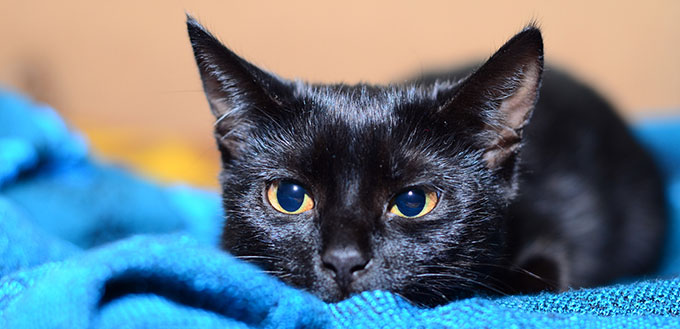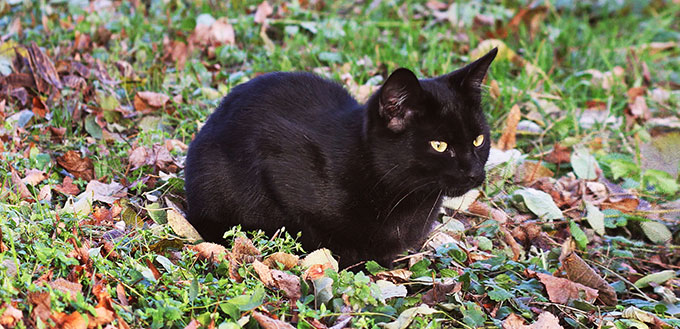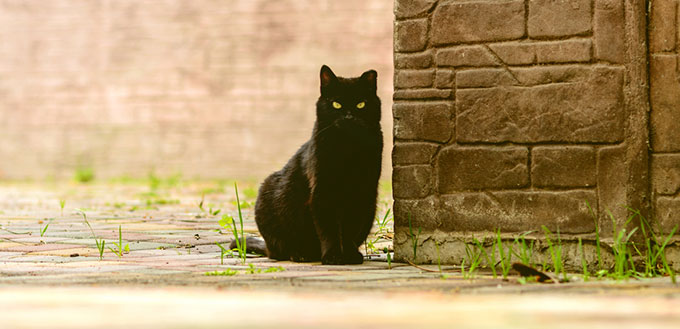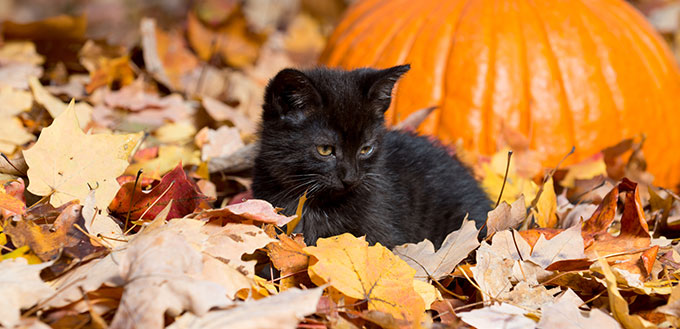Characterized by their sleek black coat and striking eyes, the Bombay is a cross between the American Short Hair and the Burmese. They have a long body, long legs and a rounded head. As an adult, you can expect them to weigh between six and ten pounds and they live for around 20 years.
The Bombay is a very friendly and intelligent cat who requires little grooming and a high-quality diet. Here are the main things that you need to know before inviting one to live in your home.

History of the Bombay Cat Breed
The gorgeous Bombay owes their very existence to the tenacity of one single cat breeder and is a fairly recent addition to the feline scene. The famous breeder and exhibitor, Nikki Horner, worked her magic at her base at Louisville in the US state of Kentucky. She was aiming for a cat that looked like a panther, with “copper penny eyes” and she nicknamed her new breed the ‘parlor panthers’. Whilst her early attempts were unsuccessful she eventually got what she wanted.
The breed is named after the sleek Indian Black Panthers that lived around Bombay. However, they are a fully domestic breed and are a lot friendlier than their namesake! Horner created the breed during the 1960s by crossing a black American Shorthair male cat with a sable-colored Burmese champion female.
The breed was first recognized by the Cat Fanciers Association in 1976 and is now fully recognized by both The International Cat Association and the American Cat Fanciers Association. However, it took more than 18 years to get to this position and it was not until 1986 that the breed was allowed to compete in the Championship Classes.
Of course, breeders are still able to cross sable Burmese with black American Shorthairs and the offspring can be black or sable. However, only the truly black kittens are eligible to be shown at Cat Fanciers Association events. It is also important to note that the Bombay is a true and distinct breed now and has its own distinctive appearance and characteristics.
Quick Facts About the Bombay Cat
- They reach sexual maturity quickly
If you are not planning on breeding from your Bombay cat and you wish to avoid unplanned pregnancies, you need to book them in to be spayed or neutered. You should do this at around five to seven months of age as this breed reaches sexual maturity quickly. They can have kittens from around five months of age!
- They are completely black
Many Bombays are completely black which means that even their paw pads are black! This is seldom seen in any other breed. Each hair is black, right down to the roots.
Read more about Black Cat Superstition
- They want to be near you
Bombays crave human company. They can be very persistent when they want your attention and were referred to as the “Velcro cat,” in the book ‘When Cats Reigned Like Kings’.
- They are not born black
Many Bombay kittens are born with faint tabby markings. However, these fade completely as they grow and all Bombay adults have a pure black coat.
- They are named after Bombay in India
The Indian city of Mumbai was formerly called Bombay. The region had populations of Black Panthers residing there are this is why the breed was called Bombay.
- They purr loudly
The Bombay is known for their very loud and distinctive purr. You will certainly know when they are happy – and your neighbors may know it too!

Things You Should Know About the Bombay Cat
You should always think carefully before you invite a kitty to come and live with you. It is a big commitment and is not something that you should enter into lightly. It is important that you research the topic thoroughly and make sure that you have the home, family and lifestyle that will fit well with the Bombay breed.
To get you started, here are the main things that you need to know about the Bombay breed and what they are like to live with.
Health
Most Bombay cats enjoy very good health and you can expect to spend many wonderful years with your gorgeous black mini-panther. However, it is still important that you feed and care for them correctly and take them for regular check-ups with your veterinary care provider. They will advise you regarding which vaccinations would be appropriate. Some health conditions are more likely to arise in Bombay cats than others and here are some details about the main ones that you should be wary of.
- Sinus problems
The main health problem that can affect Bombay cats is sinus inflammation. It can cause symptoms such as nasal discharge, frequent sneezing and discharge from the eyes. You should consult your vet about what treatments are available. Bombays have a flat facial structure and that makes them prone to excessive tear production and nasal issues.
- Craniofacial defect
Burmese cats can suffer from a defect of the craniofacial bone structure. It is a genetic condition that causes the lower jaw and nostrils to be deformed and there is also degeneration of the eyes and ears. Kittens that have two affected genes will be so badly affected that they cannot live. Those with only one copy of the mutated gene will have a mildly altered head shape. It is thought that there are many cats carrying the condition. There is a genetic test that can identify carriers.
- Hypertrophic cardiomyopathy
This is a condition where the walls of the heart get thicker and the efficiency of the heart is reduced. It is thought to have genetic origin but no test has been developed as yet.
- Obesity
This is a problem that can affect Bombay cats if they take in more calories than they burn off. It is your responsibility to give them an appropriate diet and to limit fattening snacks. You should keep a close eye on your cat’s weight and speak to your vet if you have concerns.
Related Post: Best Cat Food for Weight Loss
- Dental issues
Dental problems are common amongst all cats and the Bombay breed is no exception. You should help your kitty by brushing their teeth daily and consult your vet if you notice any bleeding or swelling of the gums.
Related Post: Best Cat Toothbrush and Best Cat Toothpaste
- Fight injuries and accidents
These can drastically affect your cat’s lifespan but can be largely avoided if your cat spends most of their time inside your house.
Feeding
All you need to do when feeding your Bombay is exercise some common sense. They do not usually have special dietary requirements unless they have a medical condition and your vet has advised a particular food.
They will do well on any high-quality wet cat food that has plenty of protein but some owners successfully feed them premium dry cat foods instead. When you collect your new cat from the breeder, they will have already been fed a particular diet and it is best to stick with this for a while as they settle in. If you do decide to change their diet later, you should do so gradually. Mix a small amount of the new food in with the old food to begin with and then gradually change the proportions. Sudden changes in food can result in a refusal to eat and digestive problems.
Bombay kittens grow slowly so you may need to feed them kitten food until they are two years old. This will contain a balance of all the nutrients that they need. Adult Bombays have a dense build and their satin coat can hide the fact that they are putting on weight. Monitor them for signs of obesity and speak to your vet if you think they need to reduce their calorie intake.
Always provide plenty of fresh water – this is especially important if your cat is eating a dry food diet. It can be hard to persuade a cat to drink and you may need to try a few things to see what works. Cat’s prefer cool and fresh water so change it several times a day and think about adding some ice cubes. Ceramic and metal dishes are more suitable as they do not transmit odors to the water. Some owners find that a cat water fountain is the best option as cats prefer to drink from running water. In the wild they would drink from streams rather than from stagnant ponds.

Care
There is nothing particularly complicated involved in looking after a Bombay cat. They require the correct food and fresh water, a clean litter tray, somewhere to sleep and regular veterinary check ups.
You should trim their claws twice a month or when you notice that they are getting long. It is best to start this when they are a young kitten. Get them used to you handling their feet and claws first before you introduce any clippers. Some cats can get startled by the noise of clippers cutting claws so use them on some spaghetti first so that your cat gets used to the noise! You will need to push their pad to extend the claw and avoid clipping near the pink nerve as that is very painful for them. It may take several sessions to cut all the claws.
Related Post: Best Cat Nail Clippers
Dental care is also important so you will need to brush your cat’s teeth every day. Again, it is best to get them used to this when they are kittens. All you have to do is lift up their gums and rub the teeth with some gauze to begin with. Then you can invest in a special cat toothbrush and some cat toothpaste. Let your cat taste the toothpaste first by applying a bit to the toothbrush and letting them lick it. Never use human toothpaste as it is not safe for cats. As you are brushing their teeth, you can check for signs of damage and dental disease.
A clean litter tray is also a must. Bombays will not like to use a litter tray that has not been cleaned out for several days. You can remove solid clumps daily and then give it a good clean out every few days. Some cats develop allergies to certain cat litters. The Bombay can have very sensitive sinuses and these can get irritated by dust. You may need to try a few different cat litters to see what suits your kitty. If you notice excessive nasal excretions and sneezing or discharge from the eyes, it may be worth talking to your vet about which cat litter would suit them better.
Regular visits to your vet are a must. They will be able to advise you on diet, weight management and general care. They will also be able to tell you which vaccinations, if any, your kitty should have.
Related Posts: Best Cat Litter Mats, Best Cat Litter Boxes and Best Cat Litter
Grooming
The sleek, glossy coat is a distinguishing feature of the Bombay cat and one that you will want to care for. These cats shed very little and the coat is short and dense so it will not take too much work to look after it.
Most owners like to brush their Bombays once a week but others find that just petting them is enough. The aim is to distribute the oils around the coat so that it looks glossy and sleek and to remove dead hairs. It would be a good idea to invest in a curry brush for your grooming sessions. They should not take too long and most cats love them. A bath is not necessary. However, you may need to wipe them down with a damp cloth if they have run through mud or dirt when they were outside. It is also important to wipe their eyes with a soft, damp cloth. Bombay cats tend to produce a lot of tears and these can irritate them and cause staining of the fur.
It is also a good idea to wipe gently inside their ears. It gives you a chance to check for any signs of infection or discharge which could indicate that something is wrong.
Temperament
The Bombay has a charming temperament that is a combination of the personalities of the American Shorthair and the Burmese. From its American Shorthair ancestors it inherits an affectionate personality and a love of being with a human family. From the Burmese side, they inherit a very inquisitive nature and they will always want to investigate what is going on in your home.
Bombays nearly always form very positive attachments to their human family. They are very adaptable and will happily live as an indoors or outdoors cat. Amongst their favorite past times they will list chasing birds in the back yard and curling up on your lap for a snooze. You will often find them rubbing up against your legs and they will want to be involved in everything that you do.
Children will form strong attachments with your Bombay who will even tolerate younger children. You can even teach them a few tricks and they can be taught to walk on a leash. They are very vocal and will tell you what. However, this sociable nature comes with responsibilities. Your Bombay will not appreciate being left at home on their own all day and could suffer from separation anxiety. Therefore, they would suit a household where at least one of the humans is home for most of the day.
Related Post: Best Cat Harnesses
Their relationship with other household pets is a little more complex and will need some careful thought and management. They will tolerate dogs but they will expect to be the boss and that may not go down very well with your pooch! Some owners find that the Bombay does not tolerate other cats in the household. It may help if you adopt two cats at exactly the same time.

The Last Word
The Bombay is medium-build cat with a stunning appearance that is agile and sleek. Although they look like and move like a Black Panther, they are a truly domesticated breed. They love to spend time with their humans but do not like to be left alone and prefer to be the center of attention. It is unlikely that they will suffer any serious long-term health issues provided you get them from a reputable breeder. This breed is fairly low-maintenance in terms of care and grooming and will fill your home with joy, love and lot of purrs.
More Pet Product Reviews
High Calorie Cat Food for Weight Gain
Cat Food for Constipation
Cat Food For Urinary Tract Health
Organic Cat Food
High Fiber Cat Food
Cat Food For Bengals
Hypoallergenic Cat Food
Cat Food for Kidney Disease
Cat Food for Indoor Cats
Cat Treats
Sources:
- Laurie L. Dove, Is My Black Cat a Bombay Cat?, HowStuffWorks
- Bombay, VCA Hospitals






I’ve had my Bombay for 10 years or so. Everything in this article fits my Bombay (Mister Kitty).